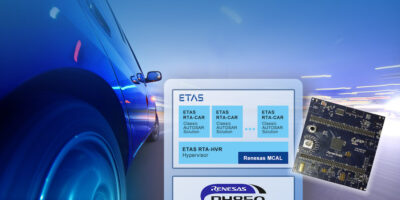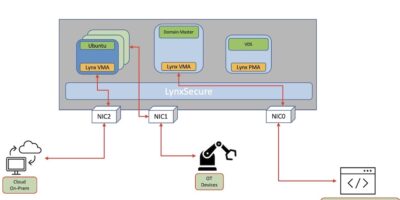Designers can integrate multiple applications into a single engine control unit (ECU) in automotive systems using the Renesas ECU virtualisation platform. Each application can be safely and securely separated to avoid interference. Customers can therefore adopt new electrical-electronic (E/E) architectures using microcontroller-based zone ECUs which support multiple logical ECUs on one physical ECU.
The ECU virtualisation platform combines Renesas’ RH850/U2x microcontrollers and ETAS’ RTA-HVR software, which is a hypervisor designed for microcontrollers with hardware virtualisation support. A demonstrator environment comprises pre-configured embedded software, tools and an interactive demonstrator environment for RH850/U2x microcontrollers.
Reflecting on the move towards zone architecture, Satoshi Yoshida, senior director, Automotive Digital Products marketing at Renesas, said: “The transition . . . increases the design burden by changing the functional role assignments between the central ECU and each zone ECU”.
“Working together with Renesas, we were able to leverage the [hardware] capabilities of the RH850/U2x [microcontrollers] to deliver a high performance, low overhead, embedded hypervisor for automotive applications that complements class-leading AUTOSAR OS technologies,” added Nigel Tracey, vice president of Vehicle Operating Systems at ETAS.
The RH850/U2x microcontrollers including RH850/U2A and RH850/U2B have a set of embedded hardware that realises the integration of multiple ASIL D-compliant software partitions. The microcontrollers are specifically designed for zone-applications targeting reduced ECU component count with minimal re-engineering overhead, explained Renesas. RH850/U2x microcontrollers include features such as hypervisor hardware support, quality of service (RH850/U2B only) support, safety and security functions and a network on chip (NoC) structure to ensure proper real-time behaviour of the individual integrated applications.
The RTA-HVR software works with the hardware virtualisation features of the Renesas RH850U2x microcontrollers to provide one or more virtual machines (VMs). VMs are separated from each other in both space (using the RH850U2x memory protection unit and guard features) and time (using the RTA-HVR VM scheduler) to meet strict automotive safety and security requirements. The RTA-HVR can build a virtual device extension (VDE). Each VM comprises one or more virtual CPU cores, a sub-set of device memory space and a collection of peripherals.
Renesas offers the RH850/U2x Zone-ECU starter kit which provides a “ready to run” configuration of RTA-HVR, showcasing VM configurations which can be single core, multi-core and multi-VM core configurations. Guest software images are provided for each of the configured VMs, including bare metal. Virtual devices are available for peripheral sharing and virtual inter-VM networking; a virtual CAN or controller area network, says Renesas.
A PC-hosted application enables users to observe and interact with the VMs at runtime. The PC application supports triggering faults to explore behaviours as a result of memory violations, for example. It can also update one VM while the other VMs are running using the no-wait OTA capabilities of the RH850/U2x. Other functions are to explore the impact of alternative VM switching mechanisms and enabling developers to see the impact of hardware quality of service features.
The ECU virtualisation software platform, including the RH850/U2x Zone-ECU starter kit will be available from the end of May 2022.







